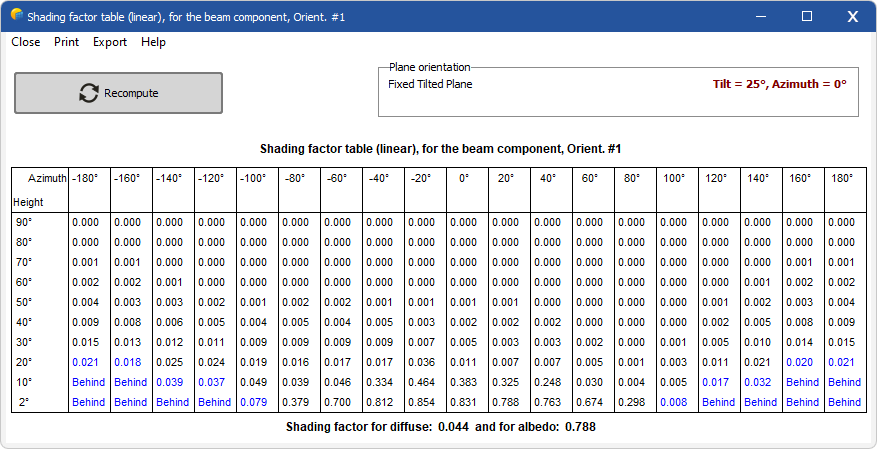Shading factor table
The Shading Factor is the shaded fraction of the PV field with respect to the full sensitive area, for a given sun orientation (values 0 = no shades, 1 = fully shaded).
In the 3D construction, the shading factor is a complex calculation. See Beam Component for a detailed description of this calculation.
Performing the calculation at each step of the simulation may take too much time. Therefore, the program builds one or several Shading factor tables of pre-calculated values in sun height (10° steps) and azimuth (20° steps), from which we can interpolate for getting the Shading factor for any sun (or space) direction. Using this type of tables constitutes the "Fast calculation" mode.
For not too big systems, the calculation of the shading factor can be fully performed at each simulation step to avoid interpolation errors (option "Slow calculation"). In this case, the shading factor table is not used to compute the shadings on the beam and circumsolar components.
Table usage
In a project, PVsyst establishes a table for each orientation, and for each of the different stages of the shadings calculation. For example, if the option "shading according to strings" is activated, PVsyst will establish additional tables that include the electrical shading mismatch losses for standard objects, and those for thin objects.
With tracking systems, PVsyst must internally establish tables for different tracker positions, for the evaluation of the Shading factor on diffuse for each position. This may take some time, therefore an approximate calculation may be used as well.
This table is therefore used:
- to compute the shading factor for diffuse and albedo components,
- to establish the iso-shadings diagram,
- at each step during the simulation when choosing the fast calculation mode.
The Shading table provides a complete analysis of the shading scene. Some other software use this table (exported from PVsyst) for their own simulations.
NB: During the elaboration of the shading table, the points (sun positions) located behind the plane of the PV field appear in blue. The highest entry among the blue ones is extrapolated from the above entries. This is to avoid artifacts in the interpolation of the shading factors. Other entries for which the sun arrives behind the plane are marked as "Behind".
